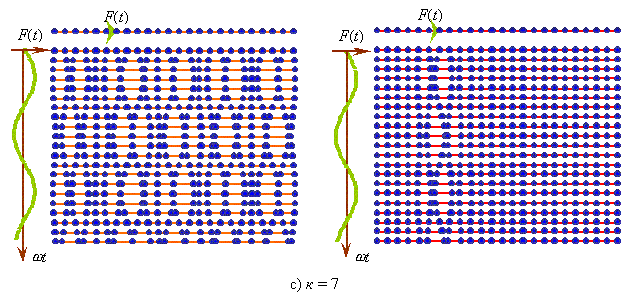SELF |
80 |
| S.B. Karavashkin, O.N. Karavashkina | |
|
|
For
the periodical regime ( |
|
|
(50) |
For the aperiodical regime ( |
|
|
(51) |
and for the critical regime ( |
|
|
(52) |
where |
|
|
(53) |
Comparing those with the related solutions (13), (16) and (17) of [2], we see that in (50)- (52) the additional multipliers appear and the solutions bifurcate into two ones describing the pattern of elements before and after the kth element. This reflects the formation of two standing waves in one line. With it the vibration diagram will considerably change its appearance, depending on the number k and the frequency. In the periodical regime with |
|
|
(54) |
the vibration amplitude vanishes in some line sections, while in other sections the vibrations remain. This is shown in Fig. 2 that presents this pattern. In the left diagrams of Figures 2a and 2b, the vibrations in the left and right parts of the line are absent, while in the left diagram of Fig. 2c we see the complex-structure standing waves. Depending on the vibration frequency, the pattern of standing waves can essentially vary, too. For example, with decreasing frequency there can form the standing waves having the oblique inflections diverging to both sides of the kth element.
|
|
|
|
|
|
|
|
Fig. 2. Diagrams of forced vibrations in a finite homogeneous free-ends elastic line in which the external force affects the interior elements of a line. The periodical vibration regime is shown in the left and the aperiodical in the right. The line parameters are m = 0,01 kg; s = 100 N/m; a = 0,01 m; n = 24; F0 = 0,48 N ; f = 30 Hz in the periodical regime; F0 = 2,0 N and f = 35 Hz in the aperiodical regime. The critical frequency is f = 31,8 Hz
|
|
In the aperiodical regime, the vibration structure also depends on the number k, though, in distinction from the periodical regime, vibrations are non-annihilated in any line section. This is well seen in the right diagrams of Figures 2 a, b, c. |
|



